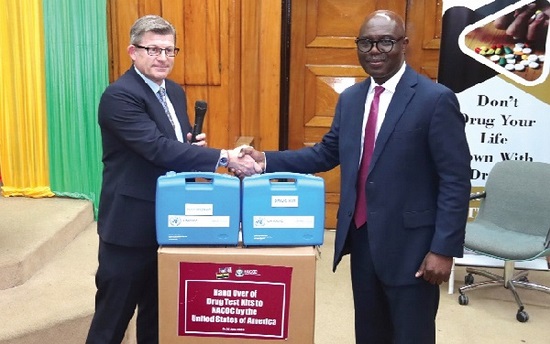Cannabis, popularly known as marijuana or weed, remains the most sourced, trafficked and used drug in Africa, the 2024 World Drug Report has revealed.
The craze for cannabis and other illicit drugs such as cocaine, heroin, methamphetamine and pharmaceutical opioids is gradually making the continent a transit hub for drug trafficking.
These drugs, the report disclosed, had infiltrated local markets, exacerbating health challenges.
This was disclosed at the regional launch of the World Drug Report 2024 by the United Nations Office on Drugs and Crime (UNODC) in Accra last Wednesday as part of the celebrations of the International Day Against Drug Abuse and Illicit Trafficking.
Current situation
“Africa is increasingly becoming a key transit hub for drugs, with substances such as cocaine from Latin America, and heroin and methamphetamine from South-West Asia passing through on their way to Europe and other destinations. Over the past 30 years, criminal networks have expanded their operations in the region,” the report said.

It stated that between January 2019 and June 2024, at least 126.4 tons of cocaine were seized en route or from West Africa, mainly in international waters in the Gulf of Guinea (30.8 tons), in Cape Verde (18.2 tons), Senegal (15.7 tons) and Guinea (5.6 tons).
This has led to a surge in drug consumption and dependency within local communities.
“Cocaine, which was previously believed to only transit the region, is increasingly used, with the number of people entering treatment for cocaine rising. In 2020, law enforcement in Niger reported the dismantlement of two clandestine laboratories producing crack cocaine for the local market. Senegal dismantled a cocaine laboratory in 2021, seizing 675kg of cocaine in the operation’, it added.
It further disclosed that non-medical use of pharmaceutical opioids like tramadol also remained high in North Africa, as well as in West and Central Africa, with over 90 per cent of global tramadol seizures occurring in Africa in the past five years.
Again, harmful drug mixtures such as Kush, Khadafi and Monkey Tail were emerging public health threats and would require member states to enhance their capacities to promptly identify and analyse new harmful domestic drug combinations.
Strategies to combat drugs
To effectively combat drug threats in the region, member states, the report said, must invest in prevention and treatment, while implementing evidence-based strategies for combating drug trafficking and organised crime, recognising the global nature of the drug problem, and the need for coordinated action.
It indicated that there must be efforts to dismantle drug networks effectively by prioritising the interception and disruption of high-level trafficking operations using key strategies, including reallocating resources to target high-profit individuals and groups at the core of the drug trade, as well as enhancing international judicial cooperation.
The report recommended the increase of the scientific testing capacity of regional laboratories, enabling the prompt detection and analysis of their components. This approach will bolster the ability of law enforcement and health agencies to respond to and mitigate the emerging drug threats effectively.
“The evidence is clear: investing in drug prevention saves lives by protecting communities from the harmful effects of drugs”, the Regional Representative at UNODC Regional Office for West and Central Africa, Dr. Amado Philip de Andrés, said, adding, “It also weakens criminal groups by reducing the profits they generate from people’ addictions.”
Graphic





